Sarah Sundin's Blog, page 487
February 17, 2012
Today in World War II History
70 Years Ago—Feb. 17, 1942: US troops arrive on Bora Bora, American Samoa.[image error]
Published on February 17, 2012 03:00
February 16, 2012
Today in World War II History
70 Years Ago—Feb. 16, 1942: At Banka Island Japanese massacre 200 civilians & 22 Australian nurses fleeing Singapore. U-boats shell tankers and refineries in US-held Aruba and Curacao. American Association of Colleges of Pharmacy approve a wartime three-year, year-round program.
Published on February 16, 2012 03:00
February 15, 2012
Today in World War II History
70 Years Ago—Feb. 15, 1942: In Singapore, British Lt. Gen. Arthur Percival surrenders to Japanese Gen. Tomoyuki Yamashita, 64,000 POWs taken. Enemy aliens ordered to be removed from restricted military zones in California.
Published on February 15, 2012 03:00
February 14, 2012
Love Letters and Victory Mail
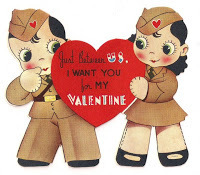 There's nothing like a love letter. When you write one, you dwell on the qualities you adore in the person you love. When you receive one, you feel warm and gooey inside.
There's nothing like a love letter. When you write one, you dwell on the qualities you adore in the person you love. When you receive one, you feel warm and gooey inside.Letters in World War II
During World War II, letters were more than romantic—they were essential to the health of a relationship. Soldiers and sailors who shipped overseas couldn't make phone calls, and of course, e-mails and text messages hadn't been invented. That left letters.
The average soldier wrote six letters a week. Those letters took anywhere from 1-4 weeks to cross the ocean to the United States. Each letter received at home assured loved ones that their serviceman was still alive and well when he wrote that letter. And each letter received on the front reminded that serviceman why he was fighting.
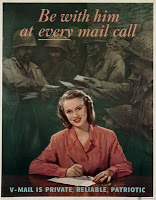
Victory Mail
The US military knew that letters from home were the single biggest morale booster, and a force with high morale fights better. However, mail bags took up valuable space on cargo ships and planes. For example, in 1945 the US Army handled over 2 billion pieces of mail.
The solution was Victory Mail, or V-Mail. Letters written on pre-printed forms were photographed and reproduced onto microfilm. The rolls of microfilm were transported overseas, where the letters were printed again at one-quarter size and mailed to their destination.
V-Mail was never mandatory, but it was successful. A letter on microfilm took up about one-thirty-seventh of the space of the same letter on paper. In the first two years of the program, the military estimated that V-Mail saved room for 5 million pounds of cargo.
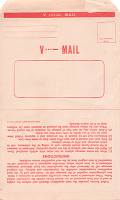
V-Mail Stationery
V-Mail stationery was a single page, printed front and back. The back contained instructions as well as space for return and mailing addresses. The letter was written on the front within the margins, boldly and in dark ink so it would reproduce well. The return and mailing addresses were repeated at the top. The form was folded in half, sealed, and sent off.
At the V-Mail processing center, each letter was censored and photographed. The original letters were stored until confirmation was received that the shipment had been received—a nice insurance policy in case a cargo ship was sunk by a U-boat or a cargo plane went down in bad weather.
V-Mail had its disadvantages. Letters had to be short. No enclosures were possible. The scent of perfume did not photograph. And lipstick prints gummed up the scanning machines—dubbed the "Scarlet Scourge" by postal workers.
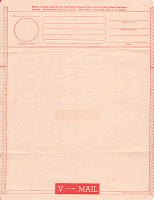
Still Victory mail and regular letters helped couples communicate. The danger of wartime lent urgency to correspondence. No one knew if that letter was the last one they'd write or receive. Couples regularly expressed feelings usually saved for special occasions.
My source for this post was the excellent on-line display on V-Mail at the Smithsonian Postal Museum: http://www.postalmuseum.si.edu/VictoryMail
Published on February 14, 2012 05:00
Today in World War II History
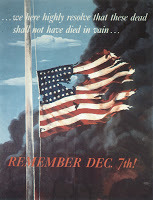 70 Years Ago—Feb. 14, 1942: USSR begins universal labor conscription. Japanese land on Sumatra at Palembang. Japanese kill 300 physicians, nurses, and patients at Alexandra Hospital, Singapore. New song in Top Ten: "Remember Pearl Harbor."
70 Years Ago—Feb. 14, 1942: USSR begins universal labor conscription. Japanese land on Sumatra at Palembang. Japanese kill 300 physicians, nurses, and patients at Alexandra Hospital, Singapore. New song in Top Ten: "Remember Pearl Harbor."
Published on February 14, 2012 03:00
February 13, 2012
Today in World War II History
70 Years Ago—Feb. 13, 1942: US, Dutch, and British ships fail to stop Japanese ships bound for Palembang, Sumatra. Final British ships, including small craft, leave Singapore as Japanese advance.
Published on February 13, 2012 03:00
February 12, 2012
Today in World War II History
 70 Years Ago—Feb. 12, 1942: German ships Gneisenau, Scharnhorst, & Prinz Eugen escape from Brest toward Wilhelmshaven. US Tenth Air Force activated at Patterson Fd. OH under Maj. Gen. Lewis Brereton, to be based in New Delhi, India.
70 Years Ago—Feb. 12, 1942: German ships Gneisenau, Scharnhorst, & Prinz Eugen escape from Brest toward Wilhelmshaven. US Tenth Air Force activated at Patterson Fd. OH under Maj. Gen. Lewis Brereton, to be based in New Delhi, India.
Published on February 12, 2012 03:00
February 11, 2012
Today in World War II History
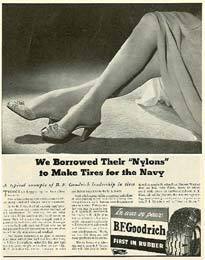 70 Years Ago—Feb. 11, 1942: US Army begins construction on Camp Stoneman in Pittsburg, California. US War Production Board takes DuPont's supply of nylon. US occupies Aruba & Curacao in Dutch West Indies with permission from free Dutch.
70 Years Ago—Feb. 11, 1942: US Army begins construction on Camp Stoneman in Pittsburg, California. US War Production Board takes DuPont's supply of nylon. US occupies Aruba & Curacao in Dutch West Indies with permission from free Dutch.
Published on February 11, 2012 03:00
February 10, 2012
Today in World War II History
70 Years Ago—Feb. 10, 1942: Japanese secure Borneo. Glenn Miller receives first gold record for selling 1 million copies of "Chattanooga Choo Choo."
Published on February 10, 2012 03:00
February 9, 2012
How's Your Heart-Soil?
 My cat Janie is pressed to the floor by the sliding glass window, ears low, whiskers forward. On the back lawn, little birds hop around eating the grass seed my husband just scattered. While Janie enjoys this, my husband does not. His purpose was to grow grass, not to entertain little cats.
My cat Janie is pressed to the floor by the sliding glass window, ears low, whiskers forward. On the back lawn, little birds hop around eating the grass seed my husband just scattered. While Janie enjoys this, my husband does not. His purpose was to grow grass, not to entertain little cats.In the parable of the sower, Jesus compared the condition of our hearts to soil types. The hard path represents the heart hardened to God's Word. The rocky soil represents a shallow heart unable to withstand trouble or persecution. The soil choked with weeds represents a heart distracted by worries and prosperity. And the fertile soil represents a heart that produces a fruitful life.
We want hearts that produce great works for God's Kingdom. However, just as farming is hard work, so is the Christian life.
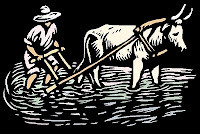 Plow
PlowSoil and hearts both need plowing to allow seed to settle deep enough to grow and to create paths for roots. Sometimes God plows our lives with trials and tough times that turn our life—our soil upside-down. We can also plow with prayer, asking the Lord to break up our hard parts, turning our lives over for examination, and letting His Holy Spirit aerate our hearts. The act of plowing is painful and sweaty—but worth it.
 Weed
WeedSoil and hearts need careful maintenance to remove rocks and weeds. "The worries of this life, the deceitfulness of wealth and the desire for other things" act just like weeds. By stealing our resources of time, energy, money, and focus, they inhibit our growth. They block the view of the Son and His empowering light. We need to be vigilant for weeds and brutal about removing them.
 Fertilize
FertilizeSoil and hearts also need proper fertilizing. For plants, the proper balance of water and nutrients leads to the greatest growth and highest yield. Likewise, our hearts need a constant and balanced diet of prayer and Bible study, fellowship and worship. Then we can yield the fruit of service and giving, ministry and outreach.
 Harvest!
Harvest!"Like seed sown on good soil, hear the word, accept it, and produce a crop—thirty, sixty or even a hundred times what was sown" (Mark 4:20)
How can you take care of your heart-soil today?[image error]
Published on February 09, 2012 05:00



